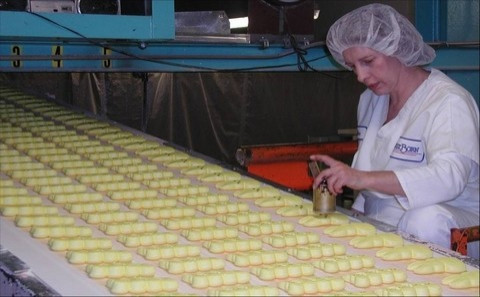Peeps Easter Candy: A Marshmallow Chick Is Born Every Six Minutes

Americans spent $1.9 billion on 7 billion pounds of Easter candy last year -- making the April holiday second only to Halloween as the biggest candy-eating occasion of the year. Every Easter, Americans consume over 700 million Marshmallow peeps shaped like chicks, bunnies and eggs, making them the most popular non-chocolate Easter candy.
The Rodda Candy Company created Peeps in the 1950s and meticulously formed each Peep by hand, a process that took 27 hours. That didn't last long, however. In 1953, Russian immigrant Sam Born bought the Rodda Candy Company and began mass producing the candy. Today, the company produces over 4 million peeps a day, approximately one every six minutes. It would take almost 3,000 years to create the number of Peeps eaten on Easter today by hand.
Peeps are made from marshmallow, corn syrup, gelatin, and carnauba wax. The process begins in a big kettle where all the ingredients are mixed together into a slurry. The slurry is then put through a whipping machine to give it a fluffy texture. The second step involves mixing sugar with coloring to give the peeps their familiar outer coating. Chicks come in yellow, pink, lavender and blue.
Next, the marshmallow is pressed into familiar shapes onto a moving belt, showered with colored sugar and put into a wind tunnel to ensure complete coverage. After the Peeps are decorated, they are packaged and shipped to stores, where people buy them in droves.
If you think every Peep is alike, think again, Matthew Pye, Peeps marketing director told the New York Times.
''No one Peeps chick is the same as another,'' he said. ''Each one has its own personality.''
A long-held urban legend about the sugary treats is that they are indestructible. In 1999, researchers from Emory University set out to test the legend and found that the eyes, made out of edible wax, wouldn't dissolve in anything. Acetone, water, diluted sulfuric acid and sodium hydroxide didn't dissolve any part of the Peep --giving some credence to the urban legend. Concentrated sulfuric acid did dissolve the candy.
Regardless of their resilience, consumers flock to Peeps in such numbers that the company can barely keep up. The company opened a retail store in 2009 that sells candy and other merchandise in order to give customers a chance to enjoy the marshmallow treats year-round.
Fans have long requested a store so that they could connect with their favorite brands throughout the year, Aubrecia Cooper Product Development Manager for the Peeps retail division, told LiveScience. [Opening stores] has been an effort in the works for some time.
© Copyright IBTimes 2024. All rights reserved.





















